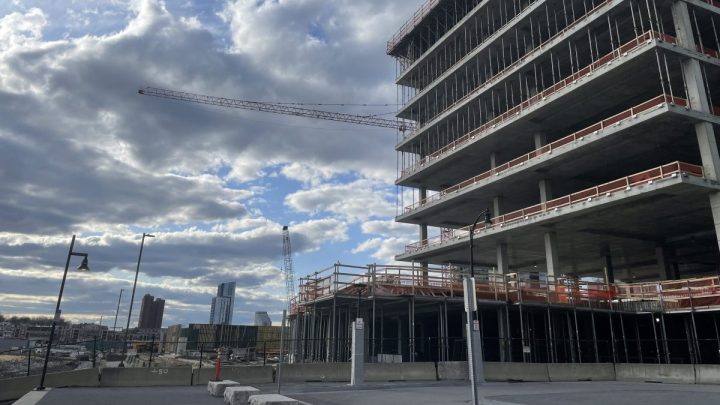
Fewer cranes on the horizon? Banking tumult could slow nonresidential construction
Fewer cranes on the horizon? Banking tumult could slow nonresidential construction

Yesterday, Marketplace covered how the regional bank tumult could hurt commercial real estate. Well, the natural follow to that is how it could affect construction of said real estate. Analysts at the financial services company Baird — which is a Marketplace Underwriter — said this week that a slowdown in all nonresidential construction was already more likely now, because regional and small banks play an outsize role in lending for those projects.
From a window in southeast Baltimore, two construction cranes can be seen: one at a hospital and another, working on a new office building. There’s a third nearby, at a marina.
All those sites are considered nonresidential construction. It’s “everything that we don’t live in,” according to Anirban Basu, chief economist at Associated Builders and Contractors, a trade group.
Spending for non-residential projects is up nearly 16% in the past year, according to the Census Bureau, and that is due in part to rising building costs. Plus, if regional banks start limiting access to capital, financing for these projects could be harder to get.
“Often it is the case that developers are tied to a regional bank, the bank they’ve been working with when they started their development firm, for instance,” Basu said. “Those regional banks are incredibly important.”
Nearly 70% of commercial real estate loans are held by banks smaller than the top 25, according to the Federal Reserve. One of those institutions is Bay State Savings Bank in western Massachusetts.
Peter Alden, the president and CEO of Bay State Savings Bank, said the bank’s lending hasn’t been affected so far. But there’s a catch.
“The next six to 12 months could be very different than the last six to 12 months,” he said. Alden said part of that is related to rising interest rates which means the bank’s customers may not be able to afford loans.
Also, the cost of the Silicon Valley Bank failure will be passed on to all banks through the insurance premiums they pay to the FDIC.
“We’ll have to factor that in as well,” Alden said.
Here’s another challenge for developers: finding enough workers.
“We’ve certainly seen a lot of projects take longer than initially expected,” said Ken Simonson, chief economist for the trade group, Associated General Contractors of America. “I think that’s a function of the tight labor market.”
The current lack of workers combined with a potential lack of capital could mean we see fewer construction cranes in the future.
There’s a lot happening in the world. Through it all, Marketplace is here for you.
You rely on Marketplace to break down the world’s events and tell you how it affects you in a fact-based, approachable way. We rely on your financial support to keep making that possible.
Your donation today powers the independent journalism that you rely on. For just $5/month, you can help sustain Marketplace so we can keep reporting on the things that matter to you.












